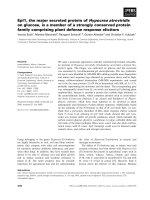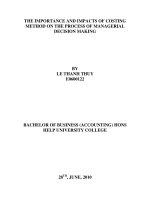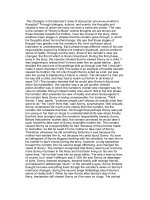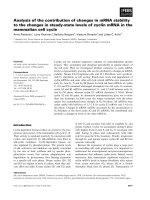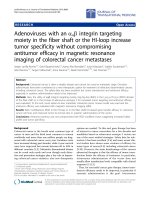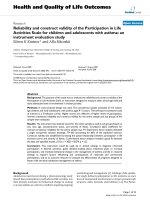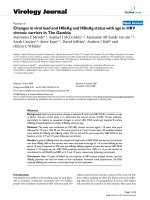The changes in degree of nerve compression on magnetic resonance imaging in patients suffering from cervical disc herniation treated with cervical traction collar in combination with
Bạn đang xem bản rút gọn của tài liệu. Xem và tải ngay bản đầy đủ của tài liệu tại đây (244.15 KB, 7 trang )
Journal of military pharmaco-medicine n08-2018
THE CHANGES IN DEGREE OF NERVE COMPRESSION ON
MAGNETIC RESONANCE IMAGING IN PATIENTS SUFFERING
FROM CERVICAL DISC HERNIATION TREATED WITH
CERVICAL TRACTION COLLAR IN COMBINATION WITH
CONSERVATIVE TREATMENT
Do Danh Thang1; Nguyen Van Chuong2; Nhu Dinh Son2
SUMMARY
Objectives: To study the changes in degree of nerve compression on MRI in patients
suffering from cervical disc herniation treated with cervical traction collar in combination with
conservative treatment. Subjects and methods: A prospective, cross-sectional study with control
group was conducted on 99 patients, of which 54 patients enrolled in the study group and 45
patients in the control group. Results:
- After 2 weeks of treatment: The average anteroposterior compression ratio increased (p =
0.003) while the average degree of compression decreased (p = 0.007) in comparison with pretreatment. There was no difference between treatment group and the control one after two
weeks of treatment in terms of MRI results
- After 6 months of treatment: The degree of compression decreased, while Torg-ratio and
anteroposterior increased compared to pre-treatment. These changes were statistically significant,
except for the change in SSI.
Conclusion: The treatment of cervical disc herniation by cervical traction collar in combination
with conservative treatment proved to be effective in decreasing the degree of nerve compression,
which was shown by the results of MRI.
* Keywords: Cervical disc herniation; Nerve compression; MRI; Cervical traction collar;
Conservative treatment.
INTRODUCTION
Spinal disc herniation is a fairly common
disease, with the most incident one is
lumbar disc herniation, followed by cervical
disc herniation [4, 6]. Cervical spondylotic
myelopathy is a common degenerative
disease associated with spinal stenosis in
the elderly. Spinal stenosis can be caused
by a variety of factors, including disc
herniation or swelling, osteophytes and
ossification of the posterior longitudinal
ligament. Those factors that compress the
spinal cord can cause spinal cord ischemia,
leading to changes in the histopathology
of the spinal cord [2]. There are several
1. 110 Military Hospital
2. 103 Military Hospital
Corresponding author: Đỗ Danh Thắng ()
Date received: 20/07/2018
Date accepted: 20/09/2018
154
Journal of military pharmaco-medicine n08-2018
methods of evaluating the degree of
spinal stenosis as well as disc herniation
[3], but MRI is currently the most common
diagnostic imaging method to accurately
measure spinal stenosis. Not only does it
reveal the width and length of the spinal
canal, but it also demonstrates in details
the spinal cord, intervertebral disc,
osteophytes, and ligaments, which are
potential causes of spinal stenosis [1, 2].
Therefore, we conducted the study with
the aim: To study the changes in degree
of nerve compression on Magnetic
Resonance Imaging in patients suffering
from cervical disc herniation treated with
cervical traction collar in combination with
conservative treatment.
* Exclusion criteria:
- Patients had comorbidity between
cervical disc herniation and other diseases
of the spinal cord including spondyloarthritis,
Pott disease, tumors, infections, amyotrophic
lateral
sclerosis
and
disseminated
sclerosis.
- Patients had cervical spinal surgeries
due to disc herniation and injuries.
- Patients had peripheral neuropathy
- Patients had diabetes and alcoholism.
- Patients under the age of 18 or over
the age of 70.
* Randomly divided the patients into
two groups:
- Group I (54 patients): The treatment
SUBJECTS AND METHODS
group, which was treated with cervical
1. Subjects.
99 patients with cervical disc herniation
diagnosed by MRI were included. These
patients were treated at 103 Military
Hospital from December 2012 to December
2015.
* Selection criteria of patients with
cervical disc herniation:
traction collar in combination with conservative
treatment regimen.
- Group II (45 patients): The control
group, which was treated only with
conservative treatment regimen.
2. Method.
- Stretching method: Use CS300 neck
- Clinical:
spine extension, 30 minutes on time and
+ related-cervical spine syndrome.
3 times a day.
+ at least one of the syndromes:
- A cross-sectional descriptive study
. Nerve root compression
with comparative control group.
. Cervical cord compression
.
Autonomic
dysfunction
vertebrobasilar insufficiency.
- The MRI of cervical spine was
and
- Subclinical: MRI of cervical spine with
results of disc herniation.
performed on the system of MAGNETOM
ESSENZA 1.5 TESLA; Siemens - Germany,
in the Department of Diagnostic Imaging,
103 Military Hospital.
155
Journal of military pharmaco-medicine n08-2018
- Indicators included:
+ Torg-Ratio =
Sagittal diameter of spinal canal
Diameter of the vertebral body
+ Anteroposterior compression ratio (APCR):
APCR =
Anteroposterior diameter of the cord
Transverse diameter of the cord
x 100%
+ Segmental stenotic index:
The diameter of the narrowest spinal canal
SSI =
The diameter of the widest spinal canal in the same vertebra
+ The degree of nerve compression had 4 levels and were called degree 1; degree 2;
degree 3; degree 4 according to Nguyen Van Chuong
- Data was analysed by SPSS software version 20.0.
RESULTS
Table 1: The MRI results of diameter (mm) of spinal canal and cord at the herniation
before the treatment.
Treatment group
(n = 54) (X ± SD)
Control group
(n = 45) (X ± SD)
p
7.36 ± 1.7
7.78 ± 2.03
p = 0.27
13.52 ± 1.17
13.76 ± 1.55
p = 0.39
5.18 ±0.93
5.44 ± 0.94
p = 0.17
Transverse diameter of the cord
13.52 ± 1.16
13.12 ± 1.22
p = 0.08
The diameter of the widest spinal
canal in the same vertebra
9.72 ± 1.48
9.69 ± 1.72
p = 0.93
Indicators
Sagittal diameter of spinal canal
Diameter of the vertebral body
Anteroposterior diameter of the cord
There was no difference between the treatment and control group in terms of the
diameter of spinal canal and cord.
Table 2: The degree of herniation according to each evaluation method.
Treatment group (n = 54)
(X ± SD)
Control group (n = 45)
(X ± SD)
p
Torg-ratio
55.13 ± 14.23
58.02 ± 18.76
p = 0.39
APCR
38.70 ± 8.24
41.93 ± 8.46
p = 0.06
SSI
75.33 ± 10.59
79.51 ± 11.54
p = 0.06
2.87 ± 0.80
2.84 ± 0.93
p = 0.88
Indicators
Degree of nerve compression
There was no difference between the treatment and control group in terms of the
degree of herniation according to different methods of evaluation.
156
Journal of military pharmaco-medicine n08-2018
Table 3: The comparison of spinal stenosis after 2 weeks of the treatment group
between 2 study groups.
Treatment group (n = 54)
Control group (n = 45)
(X ± SD)
(X ± SD)
Torg-ratio
54.8 ± 14.11
54.51 ± 16.85
0.93
APCR
39.16 ± 8.32
41.63 ± 9.14
0.2
SSI
74.86 ± 10.14
75.66 ± 9.89
0.72
2.78 ± 0.76
2.94 ± 0.87
0.36
Indicators
Degree of nerve compression
p
There was no difference demonstrated by the MRI results between the treatment
and control group after 2 weeks of treatment.
Table 4: The comparison of MRI results on spinal stenosis of treatment group after 2
weeks of treatment
Indicators
Before treatment (X ± SD)
After 2 weeks (X ± SD)
p
Torg-ratio (n = 50)
54.2 ± 14.07
54.8 ± 14.11
0.108
APCR (n = 50)
38.42 ± 8.18
39.16 ± 8.32
0.003
SSI (n = 50)
74.72 ± 10.65
74.86 ± 10.14
0.82
2.92 ± 0.78
2.78 ± 0.76
0.007
Degree of nerve compression
(n = 50)
In the treatment group, after 2 weeks of treatment, the average APCR increased
(p = 0.003) while the average degree of nerve compression decreased (p = 0.007).
Table 5: The comparison of MRI results on spinal stenosis of the treatment group
after 6 months of treatment.
Indicators
Torg-ratio (n = 31)
APCR (n = 31)
SSI (n = 31)
Degree of nerve compression
(n = 31)
Before treatment
After 6 months
(X ± SD)
(X ± SD)
53.58 ± 14.65
55.52 ± 15.38
0.005
37.0 ± 8.71
39.39 ± 8.79
0.001
71.81 ± 10.84
73.39 ± 10.47
0.06
2.87 ± 0.76
2.48 ± 0.77
0.001
p
In the treatment group, after 6 months of treatment, the average degree of nerve
compression decreased, while Torg-ratio and APCR increased. All the changes were
statistically significant, except for the SSI.
157
Journal of military pharmaco-medicine n08-2018
DISCUSSION
Previous studies have described a
number of methods of assessing the
degree of cervical spinal stenosis. While
many studies in the past conducted X-ray
imaging method, the MRI has recently
become the most common diagnostic
imaging one to accurately measure the
spinal stenosis. Not only does the MRI
reveal the width and length of the spinal
canal but it also demonstrates in details
the spinal cord, intervertebral disc,
osteophytes, and ligaments, which are
potential causes of spinal stenosis [5].
In this study, we assessed the degree
of nerve compression based on 4 indices:
- Torg-ratio: Based on two measures:
Sagittal diameter of spinal canal/diameter
of the vertebral body. Our results indicated
that the Torg-ratio of the treatment group
before the treatment was 55.13 ± 14.23
while this figure for the control group was
58.02 ± 18.76. There was no difference
between these groups prior to the treatment.
When looking at the association with
clinical characteristics, we found positive
and quite strong correlation between
the muscle strength score and Torg-ratio;
and negative and moderate correlation
between the cervical spine function score
and Torg-ratio.
- APCR: Defined by the 2 diameters of
the cord (anteroposterior diameter/transverse
diameter). Our pre-treatment results
showed the APCR of the treatment and
control group was 38.70 ± 8.24 and
41.93 ± 8.46, respectively. There was
no difference between the two groups.
158
When looking at the association with
clinical characteristics, we found negative
and moderate correlation between the
VAS score for pain and APCR (r =
0.39;
p = 0.003); negative and moderate
correlation between the cervical spinal
function score and APCR; and positive
and quite strong correlation between
muscle strength score and APCR.
- SSI: Defined by the ratio between two
measures: The diameter of the narrowest
and widest spinal canal in the same vertebra,
which reflected the degree of spinal stenosis
more accurately. Our pre-treatment results
showed the SSI of the treatment and
control group was 75.33 ± 10.59 and
79.51 ± 11.54, respectively. There was no
difference between the two groups. When
looking at the association with clinical
characteristics, we found negative and
moderate correlation between the VAS
score for pain and SSI; negative and
moderate correlation between the cervical
spine function score and SSI; and positive
and moderate correlation between muscle
strength score and SSI.
Even though these three indicators
were frequently used to assess the
degree of spinal compression on MRI,
each index had certain disadvantages:
- Torg-ratio: By using two measures
(sagittal diameter of spinal canal/posterior
diameter of the same vertebral body).
Allow us to evaluate based on the
posterior diameter (central disc herniation).
It is not suitable for those cases of median
nerve root compression (lateral disc
herniation) although this is the most common
form of disc herniation.
Journal of military pharmaco-medicine n08-2018
- APCR is defined by the 2 diameters of
the cord (anteroposterior diameter/transverse
diameter). This index can be affected
mainly due to the intrinsic variability of
spinal cord (myeloma, syringomyelia,
myelitis, cord swelling, etc.) and many
other external factors (posterior longitudinal
ligament, vertebra, etc.). In addition, the
majority of disc herniation is lateral, thus
the intervertebral disc does not directly
compress the upper diameters of the
spinal cord. Therefore, in the course of
follow-up, there exists a discrepancy
between clinical and subclinical remission.
- SSI: is defined by the ratio between
two measures: The diameter of the
narrowest and widest spinal canal in the
same vertebra. However, in several
cases, the narrowest part of spinal canal
is not caused by disc compression but
other factors such as: the swelling and
hyperplasia of vertebra and ligament
system, etc. Thus, if this indicator is used,
its results are sometimes inaccurate.
As a result, in this study, we further
determined the degree of nerve compression
proposed by Nguyen Van Chuong. “The
degree of nerve compression” was
determined by the MRI cross-sectional
image of the vertebra, at the maximal
level of compression of the intervertebral
disc on the spinal cord. “The degree of
nerve compression” had 4 levels, called
degree 1; degree 2; degree 3; degree 4
according to the number on the picture.
The severity also increased in accordance
with the order of degree. The results prior
to the treatment indicated that “the average
degree of nerve compression” was 2.87 ±
0.80 in the treatment group and 2.84 ±
0.93 in the control group, which implied
no difference between these two groups.
However, in the comparative analysis, we
found no association between several
clinical characteristics and the degree of
disc compression. The MRI results after
two weeks of treatment suggested that
the average APCR increased (p = 0.003)
while the average degree of compression
decreased (p = 0.007) in comparison with
the results before the treatment. Nevertheless,
there was no difference between the two
groups after two weeks of treatment in
terms of MRI results. After six months of
treatment, the Torg-ratio and APCR increased,
while the degree of compression decreased
compared to the results before the treatment.
These changes were statistically significant
with p < 0.05. The SSI after two weeks
and six months of treatment increased
and it had no statistical significance.
CONCLUSION
The treatment of cervical disc herniation
by cervical traction collar in combination
with conservative treatment proved to be
effective in decreasing the degree of
nerve compression, which was shown by
the results of MRI.
REFERENCE
1. Nguyen Thi Anh Hong. Cervical spinal
stenosis: The value of MRI based on 300
cases. Medical Journal of HoChiMinh City.
Neurology Topic No.1, pp.56-58.
159
Journal of military pharmaco-medicine n08-2018
2. Cook C, Braga-Baiak A, Pietrobon R et
al. Observer agreement of spine stenosis on
magnetic resonance imaging analysis of
patients with cervical spine myelopathy.
J Manipulative Physiol Ther. 2008, 31 (4),
pp.271-276.
herniation: Case report and Literature review.
Surg Neurol. 1996, 45 (4), pp.359-361.
3. Mysliwiec L.W, Cholewicki J, Winkelpleck
M.D et al. MSU classification for herniated
lumbar discs on MRI: toward developing
objective criteria for surgical selection.
Eur Spine J. 2010, 19 (7), pp.1087-1093.
6. Wilson J.R, Barry S, Fischer D.J, et al.
Frequency, timing and predictors of neurological
dysfunction in the nonmyelopathic patient
with cervical spinal cord compression, canal
stenosis, and/or ossification of the posterior
longitudinal ligament. Spine. 2013, 38 (22 Suppl 1),
pp.S37-54.
4. Rumana C.S and Baskin D.S. BrownSequard syndrome produced by cervical disc
160
5. Swartz E.E, Floyd R.T and Cendoma M.
Cervical spine functional anatomy and the
biomechanics of injury due to compressive
loading. J Athl Train. 2005, 40 (3), pp. 155-161.
